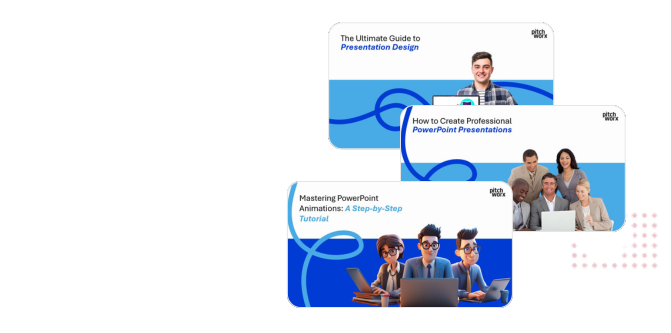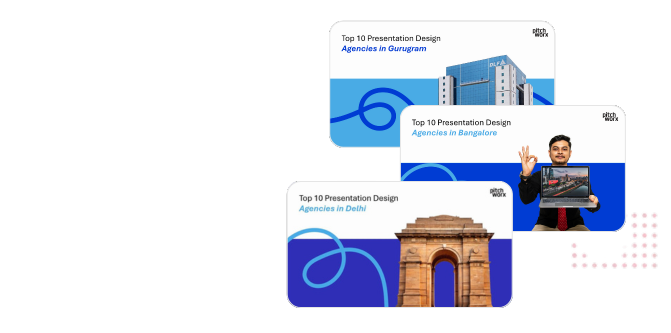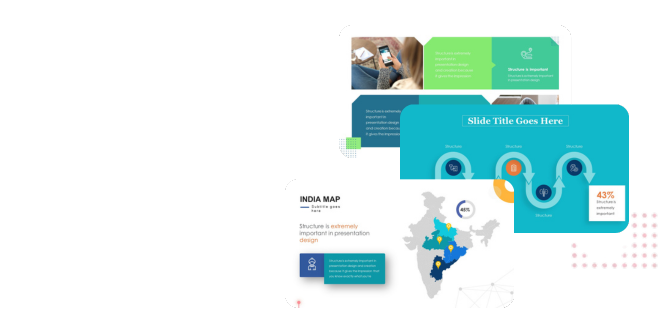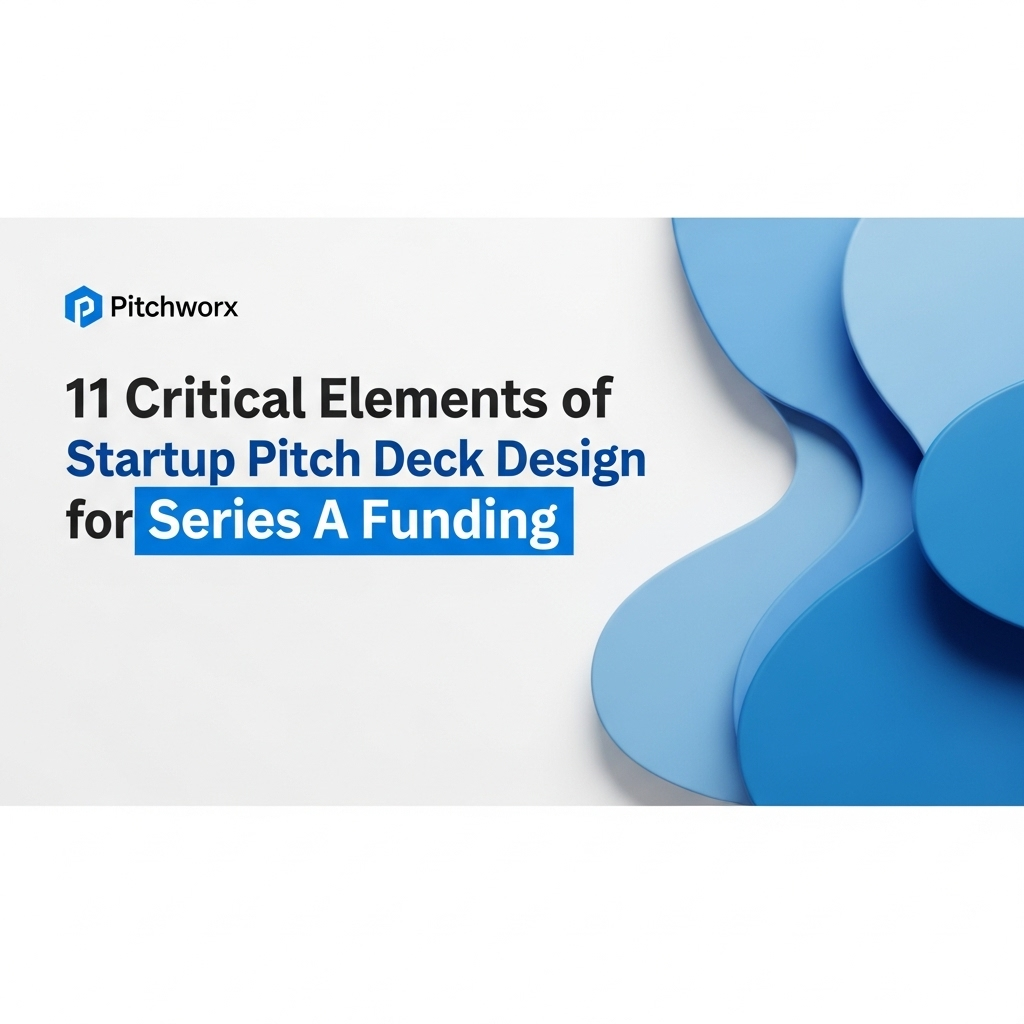Securing Series A funding is a monumental leap for any startup, moving from a promising idea to a scalable business. But the startup pitch deck design that got you your seed money won’t cut it here. Series A investors aren’t just betting on a vision; they’re investing in proven traction and a predictable growth engine. This is where most founders stumble—by treating the Series A deck as a simple update rather than a fundamental strategic shift in storytelling.
Our team at PitchWorx has seen this firsthand. Over 13 years, we’ve helped countless startups navigate this crucial transition. The difference between a deck that gets a second meeting and one that gets a polite “no” often comes down to demonstrating credibility through data, not just declaring a bold vision. It’s about showing, not just telling.
Quick Answer
A successful startup pitch deck design for Series A funding must prove product-market fit and a scalable growth model. According to a DocSend Startup Funding Report, investors spend under three minutes on a winning deck, so clarity is key. A powerful deck should prioritize: 1. Hard metrics like MRR, CAC, and LTV over vanity metrics, 2. A detailed go-to-market strategy with clear unit economics, and 3. A defensible financial model tied directly to the funding ask.
Table of Contents
- From Seed Story to Series A Science
- The V.C.S. Framework: Vision, Credibility, and Scale
- Component 1: Vision Reimagined with Data
- Component 2: Credibility Forged in Traction
- Component 3: Scale as a Predictable Engine
- Common Series A Deck Mistakes (and How to Fix Them)
- Frequently Asked Questions
- Conclusion: Building Your Investment-Grade Narrative
From Seed Story to Series A Science
The journey from a seed-stage startup to a Series A contender is a transition from evangelism to execution. Your seed deck was likely built on a powerful story, a compelling problem, and the promise of a brilliant team. You sold the dream. For Series A, you must sell the reality. Investors at this stage are looking for evidence that you’ve found product-market fit and have a repeatable, scalable plan to acquire customers.
This requires a complete reframing of your narrative. Every claim must be backed by data. Your vision must be grounded in tangible market feedback. Your team slide is less about prestigious past roles and more about proven execution ability. As you approach your startup pitch deck design for this critical round, think less like a storyteller and more like a data scientist who can also tell a great story. The art is in weaving your metrics into a compelling narrative of inevitable growth.
The V.C.S. Framework: Vision, Credibility, and Scale
To structure a narrative that meets Series A expectations, we at PitchWorx developed the V.C.S. (Vision, Credibility, Scale) framework. It ensures your deck addresses the three core questions every Series A investor has:
- Vision: Is the market opportunity still massive, and how has your understanding of it deepened since the seed round?
- Credibility: Have you proven you can execute? Where is the undeniable evidence (traction) that your solution works and customers want it?
- Scale: Do you have a clear, capital-efficient plan to grow 10x? Is the growth engine predictable?
This framework forces you to move beyond abstract claims and build your case on a foundation of proof. It’s a logical progression that builds confidence with every slide, culminating in an investment ask that feels like the obvious next step, not a hopeful leap of faith.
Component 1: Vision Reimagined with Data
In your seed deck, the “Vision” was about the art of the possible. For Series A, it’s about the science of the addressable. You need to revisit your market sizing slides (TAM, SAM, SOM) and infuse them with data gathered from your initial market entry.
Revisiting the Problem and Market Size
Your problem slide should evolve. Instead of just describing a user’s pain point, quantify it. How much time or money is this problem costing your target segment? Use data from your early customers to validate the severity of the problem. For example, “Our beta users in the logistics sector reduced documentation errors by 40%, saving an average of 20 hours per week.”
For market size, move from top-down analysis (e.g., “The global logistics market is $8 trillion”) to a bottom-up build. Show your work: how many target customers are there, what is your realistic price point (validated by early sales), and what does that math look like? This demonstrates a sophisticated understanding of your specific beachhead market, which is far more convincing.
Component 2: Credibility Forged in Traction
This section is the heart of your Series A pitch deck design. Credibility is no longer about your team’s résumés; it’s about the results that team has delivered. This is where you present undeniable, quantitative proof of product-market fit.
The Unbeatable Traction Slide
The traction slide is the single most important slide in your deck. It must be clear, concise, and focused on the metrics that matter for your business model. Avoid vanity metrics like downloads or sign-ups. Focus on the hard numbers:
- Monthly Recurring Revenue (MRR): Show a clear, upward-trending chart over the last 12-18 months.
- Customer Acquisition Cost (CAC): Demonstrate that you can acquire customers efficiently.
- Lifetime Value (LTV): Show that the value of a customer is significantly higher than the cost to acquire them (ideally LTV:CAC > 3:1).
- Churn Rate: Low churn proves your product is sticky and valuable.
Presenting this data effectively is critical. Our investor pitch deck solutions often focus on creating a single, powerful chart that overlays these key metrics to tell a story of healthy, capital-efficient growth. Visual simplicity is key to making your impressive numbers land with impact.
MRR Growth (MoM)
15-20%
LTV:CAC Ratio
> 3:1
Net Revenue Retention
> 100%
Beyond the numbers, include qualitative proof. A slide with logos of recognizable customers and 2-3 powerful testimonials can add a human element to your data-driven story.
Our Experience at PitchWorx
With over a decade of presentation design experience and 150,000+ slides created, PitchWorx is an ISO 27001 certified agency trusted by startups and Fortune 500 companies across US, India, and UAE markets. We specialize in transforming complex data into clear, persuasive investment narratives.
Component 3: Scale as a Predictable Engine
Once you’ve established credibility, the final piece is to show investors how their capital will fuel a well-oiled growth machine. This isn’t about vague promises of “scaling marketing.” It’s about a detailed, metrics-driven plan.
Go-to-Market and Financials
Your go-to-market (GTM) slide should detail the specific channels you will use to acquire the next wave of customers. For each channel (e.g., content marketing, paid social, direct sales), you should have data on conversion rates and CAC from your experiments to date. Show the math: “We will invest $500k in paid search, which at our current CAC of $250 will yield 2,000 new customers.”
Your financial projections must be a bottom-up model based on these GTM assumptions, not a top-down grab for a percentage of the market. This ties your entire story together. In our work with FinTech startups, a granular financial model is often the deciding factor, as it demonstrates operational command of the business.
The Ask and Use of Funds
Finally, your “Ask” slide should be a direct consequence of your plan. Don’t just say you’re raising $5M. Break down exactly how that capital will be allocated: 40% to engineering to build key features, 40% to sales and marketing to execute the GTM plan, and 20% to G&A. Show what milestones this funding will help you achieve, setting you up for a successful Series B.
Common Series A Deck Mistakes (and How to Fix Them)
Even with a solid framework, founders often make unforced errors. Having reviewed thousands of decks, our team has noticed a few recurring patterns. Here’s a look at the core differences between a Seed and Series A pitch, and the common pitfalls to avoid.
| Deck Component | Seed Deck Focus (The “What If”) | Series A Focus (The “What Is”) |
|---|---|---|
| Problem | A compelling, relatable user story. | A quantified market inefficiency, proven by user data. |
| Traction | Early adopters, waitlist numbers, positive survey feedback. | MRR growth, LTV:CAC ratio, low churn, cohort analysis. |
| Team | Founder-market fit, relevant past experience. | Proven ability to execute, hire, and manage a team. |
| Financials | High-level, top-down market opportunity. | Detailed, bottom-up 3-5 year model based on unit economics. |
Mistakes to Avoid
- The “Hockeystick of Hope”: Presenting financial projections that show exponential growth without the underlying unit economics to support it. Your model must be believable.
- Hiding Bad Numbers: Investors will find the weaknesses during due diligence. It’s better to be upfront about challenges (like a temporary spike in churn) and explain what you learned and how you fixed it. This builds trust.
- A Crowded, Confusing Deck: As mentioned in the Harvard Business Review, data storytelling is about clarity, not complexity. Use visuals, call out key numbers, and follow the “one idea per slide” rule. Don’t force an investor to spend five minutes deciphering a single chart.
Related Services
Frequently Asked Questions
How many slides should a Series A pitch deck have?
Aim for 15-20 slides. Brevity is critical. According to multiple venture capital analyses, investors spend very little time on the initial review. Each slide must be impactful and contribute directly to the V.C.S. framework. Any additional data can be kept in an appendix for follow-up questions.
What MRR do I need for a Series A?
While there’s no magic number, most VCs look for startups with an MRR between $50k and $150k, which translates to roughly $1M in Annual Recurring Revenue (ARR). More importantly, they want to see a consistent month-over-month growth rate of 15-20% or higher, proving your business has momentum.
Should I include a competitive landscape slide?
Yes, but do it strategically. Avoid the standard 2×2 matrix where you are in the top right. Instead, use the slide to show your unique differentiation and deep understanding of the market. Acknowledge your competitors but clearly articulate why your approach, technology, or business model gives you a sustainable advantage.
How far back should my traction data go?
Typically, 12 to 18 months of historical data is sufficient. This provides enough context to show trends in growth, churn, and customer behavior without overwhelming the investor. The key is to demonstrate a clear and accelerating growth trajectory leading up to the fundraise.
Can I use a standard template for my Series A deck?
Templates from famous decks (like Airbnb’s) are a good starting point for structure, but they should not be copied verbatim. Your business is unique, and your deck must tell your specific data-driven story. A generic template can signal a lack of strategic thought to discerning investors.
What’s more important: the design or the content?
Content is king, but design is the kingdom. Your metrics and strategy are paramount. However, a poor design can obscure great content, making it hard to understand and unprofessional. A clean, professional design ensures your powerful message is delivered with clarity and credibility, which is why expert startup pitch deck design is a worthwhile investment.
Conclusion: Building Your Investment-Grade Narrative
Crafting a Series A pitch deck is less about creating slides and more about building an investment-grade narrative. It’s the ultimate test of your strategic clarity as a founder. By moving beyond the seed-stage story and embracing a data-driven approach built on the V.C.S. framework—Vision, Credibility, and Scale—you demonstrate that you have not only a great idea but also a predictable business.
Remember to ground your vision in market data, prove your credibility with undeniable traction, and present a scalable plan that turns capital into growth. This rigorous approach will not only prepare you for investor meetings but also force a level of operational discipline that will serve your company long after the round is closed.
Ready to elevate your presentations? Our presentation design services help businesses across US, India, UAE markets. View our portfolio.










